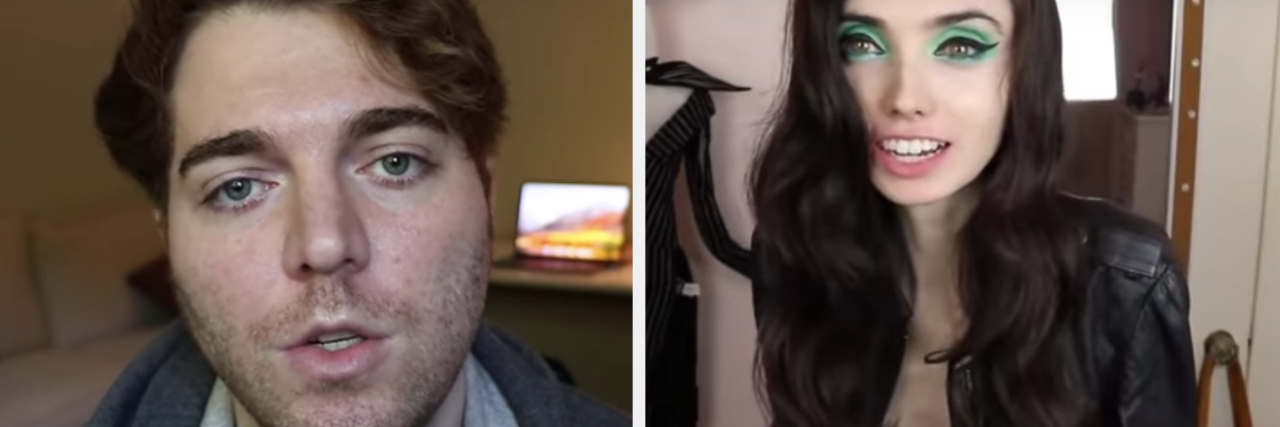The One Thing I Would Change About Shane Dawson’s New Video as Someone in Anorexia Recovery
Editor's Note
We did not embed Dawson’s video in this piece because it might be triggering to some people in our community. If you need support, you can contact the Crisis Text Line by texting “NEDA” to 741741.
Last Friday afternoon at the office as I took a social-media-filled break, I saw Shane Dawson had released his latest video. For those who are not as YouTube-obsessed as I am, Dawson is a unique filmmaker on the platform who makes long-form content diving into investigative issues. When he comes out with a new video, I automatically watch it the second I can.
I came home from work ready to start my weekend and got amped up to watch the video. Then I started watching and the first thing I saw on my screen was an eating disorder trigger warning. What? My life in recovery from anorexia is filled with lots of niche Instagram recovery accounts and blogs on eating disorders, but I was not expecting this on one of the most popular YouTube channels ever.
I was enthralled as I watched Dawson, who has struggled with body image and food issues, interview fellow YouTuber Eugenia Cooney. For a long time, people were concerned with Cooney’s ultra-thin body, as seen in her videos and other social media. In early 2019 she took time off from the internet for health reasons. Dawson’s video was her introduction back on YouTube as she was ready to share her eating disorder recovery story. It was brave of Cooney to open up publicly about going to rehab to get help for her mental and physical well-being.
I am thrilled Dawson is using his following of 21 million subscribers to talk about the serious, even life-or-death issue of eating disorders. My niche world of eating disorder recovery Instagrams, videos and articles is now spreading to mainstream media, as this video hit #1 on YouTube trending after its release.
Dawson’s video is an incredible step in continuing to raise awareness about eating disorders and how they can affect anyone. I loved that Dawson focused on Cooney as a human being with interests and a personality beyond her eating disorder. Before she took a break from the internet, it was almost all anyone talked about in response to her content. This video showed that individuals are more than their eating disorders and should not be defined by them.
Dawson treated the subject matter seriously, consulting YouTuber and licensed therapist Kati Morton before interviewing Cooney. Morton brought up the difficulties in talking to someone in recovery, which added to the quality of the video in educating people on eating disorders.
Overall, the filmmaking was incredible and Cooney’s story is compelling. I have to say though, while there was indeed a trigger warning, the mass incorporation of videos and photos of Cooney pre-recovery was unnecessary. Yes, it made sense to include images of her given they are public and can represent how seriously ill she was. However, I found myself body checking and comparing myself to her after watching Cooney’s extreme thinness for an hour. I wish the inclusion of photos of Cooney was scaled back. This only perpetuates that you have to be extremely thin to have an eating disorder.
Kati Morton was an important element of the work given she did explain that there are many types of eating disorders and you do not have to be underweight to have one. However, this was unbalanced in comparison to the excessive showing of Cooney’s pre-recovery body.
I am inspired that Dawson chose to use his platform to talk about the seriousness of eating disorders, educating his audience and raising more awareness through the telling of one individual’s story. But it does raise a question that I continue to ponder given content like Netflix’s “To The Bone” and now this: how do we educate people on eating disorders through digital media without focusing on their looks in a triggering way?
I do not know the answer to this given the physical impact of eating disorders and that weight can be a sign of suffering in some cases. But since many people with eating disorders are not underweight, I hope in the future more media content can be created to show the perspective of those with this experience.
Minimizing the “before” photos in media can be one good place to start. In this case, Dawson could have decreased the trigger potential of his content by incorporating less pre-recovery video of Cooney. It is important for people to recognize how serious these illnesses are, but we need to move beyond the shock factor of emaciation.
I have so much respect for Dawson talking about this on his channel and the potential it has to help many people. I am glad he is supporting Cooney in her recovery journey and making space online to have an open discussion about eating disorders. I hope we can expand this dialogue to explore minimizing the triggering potential and stereotyping of eating disorders in mainstream media going forward.

